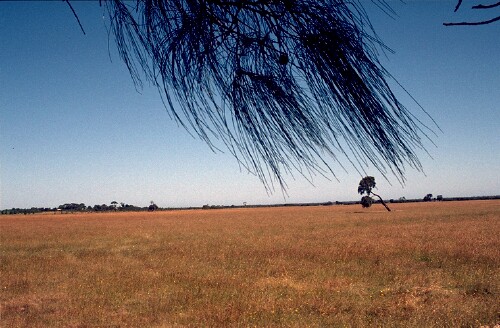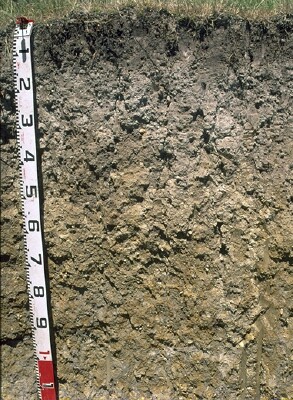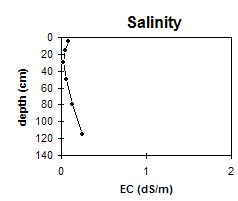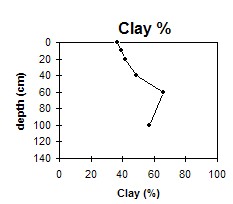GP47
| SITE: GP47 | Property: McLennan |
| Location: McLoughlans Beach | Aust. Soil Class.: Bleached-Sodic, Mesotrophic, Grey DERMOSOL |
| General Landscape Description: Level alluvial plain (0-1 degrees slope) with occasional wind blown sheets. | Site Description: Grazing paddock. |
| Geology: Pleistocene alluvial deposits. | |

GP47 Landscape
Soil Profile Morphology:
Surface Soil
| A1 | 0-10 cm | Dark greyish brown (10YR4/2); heavy silty clay loam; moderate coarse polyhedral, parting to moderate medium polyhedral structure; very firm consistence dry; pH 5.4; gradual change to: |  GP47 Profile |
| A2 | 10-20 cm | Dark greyish brown (10YR4/2) conspicuously bleached (10YR7/2d); heavy silty clay loam; moderate coarse prismatic; parting to moderate polyhedral structure; very firm consistence dry; pH 5.8; clear change to: | |
| Subsoil | |||
| B21 | 20-40 cm | Greyish brown (10YR5/2); light medium clay; moderate coarse prismatic, parting to moderate polyhedral structure; strong consistence dry; pH 5.9; clear and wavy change to: | |
| B22 | 40-60 cm | Greyish brown (10YR5/2) with faint yellowish brown (10YR6/4) mottles; medium clay silty; moderate coarse prismatic, parting to moderate coarse polyhedral structure; firm consistence moist; pH 6.0; gradual change to: | |
| B23 | 60-100 cm | Light brownish grey (10YR6/2) with yellowish brown (10YR5/6) mottles; light medium clay; firm consistence moist; pH 6.2; gradual and wavy change to: | |
| B24 | 100-130 cm | Grey (10YR6/1) with brownish yellow (10YR6/6) mottles; light medium clay; strong coarse prismatic, parting to strong coarse blocky, parting to strong medium polyhedral structure; very firm consistence dry; pH 5.8. | |
Key Profile Features:
- Lack of strong texture contrast between surface (A) and subsoil (B) horizons.
- Conspicuously bleached A2 horizon.
pH | Salinity Rating | |||
Surface (A1 horizon) | Strongly Acid | Very Low | Non-Sodic | None1 |
Subsoil (B21 horizon) | Moderately Acid | Very Low | Non-Sodic | None2 |
Deeper subsoil (at 1 m) | Slightly Acid | Low | Sodic | None |
 The surface soil is strongly qcid. The subsoil is moderately acid, becoming slightly acid at 80 cm. |  The salinity rating is very low until about 1 m depth where it increases slightly. |  The clay content gradually increases with depth down the soil profile. |
Management Considerations:
Whole Profile
- Plant available water capacity (PAWC) is considered to be moderate (estimated at 119 mm) for the top metre of the soil profile. This is based on available laboratory data.
- The surface (A1) horizon is strongly acid. As a result, deficiencies in molybdenum, potassium and phosphorus may occur. Manganese toxicity may also occur in strongly acid soils, particularly when poorly drained (as waterlogging may bring manganese into solution).
- Aluminium toxicity can also occur in strongly acid soils. The levels of exchangeable aluminium measured at the site (i.e. 11 mg/kg) are quite low. A pH/aluminium test sampled across the paddock would be most appropriate to determine whether lime is needed to raise soil pH. However, other factors need to be considered before lime is recommended (e.g. pasture species grown, method of application, local trial responses, soil surface structure and likely cost/benefit).
- The inherent fertility of the surface (A1) horizon (based on the sum of the exchangeable calcium, magnesium and potassium cations) is relatively low. The high levels of organic matter and nitrogen at this site are important for improving soil fertility, water holding capacity and enhancing surface soil structure (especially with the high silt content of 37%).
- Deficiencies in molybdenum and phosphorus are likely to occur in strongly acid soils. If lime is required, an application may assist in alleviating molybdenum deficiency and will increase phosphorus qvailability, as well as increasing soil pH. Phosphorus tends to become 'fixed' by high levels of exchangeable aluminium.
- The relatively high wilting point value (i.e. 20%) indicates that plants will not be able to utilise light rains falling on relatively dry soil. If the soil dries out, then small falls of rain may not be sufficient to wet the soil above permanent wilting point. The high wilting point also indicates that water is ‘held tightly’ by the soil which decreases its availability to plants as the water content approaches this point.
- The surface (A1) horizon is non-sodic but slight dispersion occurs after remoulding. This indicates that disturbance (e.g. by tillage) to this horizon whilst in a moist to wet condition may result in some structural degradation (e.g. ploughpan development).
- The presence of a conspicuous bleach within the subsurface (A2) horizon indicates periodic waterlogging above a more slowly permeable subsoil.
- The upper subsoil is non-sodic (strong dispersion occurs only after remoulding) but root movement will still be restricted by its dense and coarsely structured nature.
- The subsoil has a relatively low inherent fertility throughout (based on the sum of the exchangeable calcium, magnesium and potassium cations). The cations are dominated by exchangeable magnesium (> ??% of total cations) which may create nutrient imbalances. For example, high levels of exchangeable magnesium may result in potassium deficiencies in some soils (Baker and Eldershaw 1992).
- The presence of mottling in the deeper subsoil indicates that the profile is seasonally waterlogged.
Profile described by Mark Imhof and Ian Sargeant


